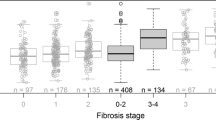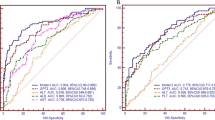Abstract
Macrophages regulate the fibrotic process in chronic liver disease. The aim of the present pilot study was to evaluate two new macrophage-specific serum biomarkers [soluble CD163 (sCD163) and soluble mannose receptor (sMR, sCD206)] as potential fibrosis markers in patients chronically infected with hepatitis C virus (HCV). Forty patients with chronic hepatitis C were included from two hospital clinics. On the day of inclusion, transient elastography (TE) was performed to assess the fibrosis stage, and blood samples were collected for the measurement of sCD163 and sMR. The plasma concentrations of both biomarkers were significantly higher in patients infected with HCV and with cirrhosis compared to those with no/mild liver fibrosis (5.77 mg/l vs. 2.49 mg/l and 0.44 mg/l vs. 0.30 mg/l for sCD163 and sMR, respectively). The best separation between groups was obtained by sCD163 [area under the receiver operating characteristic curve (AUC) 0.89 (95 % confidence interval [CI] 0.79–0.99)] as compared to sMR [AUC 0.75 (95 % CI 0.61–0.90)]. sCD163 and sMR correlated significantly (r 2 = 0.53, p < 0.0001). Interestingly, sCD163 also correlated significantly with TNF-α (presented in a previous publication), which is shed to serum by the same mechanism as sCD163 (r 2 = 0.40, p < 0.0001). In conclusion, the macrophage-related markers sCD163 and sMR are significantly higher in patients chronically infected with HCV and with cirrhosis than in those with no/mild fibrosis. sCD163 is a promising new fibrosis marker in patients infected with HCV.


Similar content being viewed by others
References
Adams LA (2011) Biomarkers of liver fibrosis. J Gastroenterol Hepatol 26:802–809
Castera L (2012) Noninvasive methods to assess liver disease in patients with hepatitis B or C. Gastroenterology 142:1293–1302
Van Thiel DH, Gavaler JS, Wright H, Tzakis A (1993) Liver biopsy: its safety and complications as seen at a liver transplant center. Transplantation 55:1087–1090
McGill DB, Rakela J, Zinsmeister AR, Ott BJ (1990) A 21-year experience with major hemorrhage after percutaneous liver biopsy. Gastroenterology 99:396–400
Regev A, Berho M, Jeffers LJ, Milikowski C, Molina EG, Pyrsopoulos NT, Feng ZZ, Reddy KR, Schiff ER (2002) Sampling error and intraobserver variation in liver biopsy in patients with chronic HCV infection. Am J Gastroenterol 97:2614–2618
Bedossa P, Dargère D, Paradis V (2003) Sampling variability of liver fibrosis in chronic hepatitis C. Hepatology 38:1449–1457
Grønbaek K, Christensen PB, Hamilton-Dutoit S, Federspiel BH, Hage E, Jensen OJ, Vyberg M (2002) Interobserver variation in interpretation of serial liver biopsies from patients with chronic hepatitis C. J Viral Hepat 9:443–449
Ganne-Carrié N, Ziol M, de Lédinghen V, Douvin C, Marcellin P, Castéra L, Dhumeaux D, Trinchet JC, Beaugrand M (2006) Accuracy of liver stiffness measurement for the diagnosis of cirrhosis in patients with chronic liver diseases. Hepatology 44:1511–1517
Foucher J, Chanteloup E, Vergniol J, Castéra L, Le Bail B, Adhoute X, Bertet J, Couzigou P, de Lédinghen V (2006) Diagnosis of cirrhosis by transient elastography (FibroScan): a prospective study. Gut 55:403–408
Friedrich-Rust M, Ong MF, Martens S, Sarrazin C, Bojunga J, Zeuzem S, Herrmann E (2008) Performance of transient elastography for the staging of liver fibrosis: a meta-analysis. Gastroenterology 134:960–974
Ziol M, Handra-Luca A, Kettaneh A, Christidis C, Mal F, Kazemi F, de Lédinghen V, Marcellin P, Dhumeaux D, Trinchet JC, Beaugrand M (2005) Noninvasive assessment of liver fibrosis by measurement of stiffness in patients with chronic hepatitis C. Hepatology 41:48–54
Wynn TA, Barron L (2010) Macrophages: master regulators of inflammation and fibrosis. Semin Liver Dis 30:245–257
Møller HJ, Peterslund NA, Graversen JH, Moestrup SK (2002) Identification of the hemoglobin scavenger receptor/CD163 as a natural soluble protein in plasma. Blood 99:378–380
Rødgaard-Hansen S, Rafique A, Christensen PA, Sandahl T, Maniecki M, Nexø E and Møller HJ (2013) A soluble form of the macrophage related mannose receptor (MR/CD206) is present in human serum and elevated in critical illness. Submitted for publication
Gazi U, Rosas M, Singh S, Heinsbroek S, Haq I, Johnson S, Brown GD, Williams DL, Taylor PR, Martinez-Pomares L (2011) Fungal recognition enhances mannose receptor shedding through dectin-1 engagement. J Biol Chem 286:7822–7829
Hintz KA, Rassias AJ, Wardwell K, Moss ML, Morganelli PM, Pioli PA, Givan AL, Wallace PK, Yeager MP, Guyre PM (2002) Endotoxin induces rapid metalloproteinase-mediated shedding followed by up-regulation of the monocyte hemoglobin scavenger receptor CD163. J Leukoc Biol 72:711–717
Grønbaek H, Sandahl TD, Mortensen C, Vilstrup H, Møller HJ, Møller S (2012) Soluble CD163, a marker of Kupffer cell activation, is related to portal hypertension in patients with liver cirrhosis. Aliment Pharmacol Ther 36:173–180
Andersen ES, Ruhwald M, Moessner B, Christensen PB, Andersen O, Eugen-Olsen J, Weis N (2011) Twelve potential fibrosis markers to differentiate mild liver fibrosis from cirrhosis in patients infected with chronic hepatitis C genotype 1. Eur J Clin Microbiol Infect Dis 30:761–766
Møller HJ, Hald K, Moestrup SK (2002) Characterization of an enzyme-linked immunosorbent assay for soluble CD163. Scand J Clin Lab Invest 62:293–299
Hanley JA, McNeil BJ (1983) A method of comparing the areas under receiver operating characteristic curves derived from the same cases. Radiol 148:839–843
Dennis C (2001) Haemoglobin scavenger. Nature 409:141
Martinez-Pomares L (2012) The mannose receptor. J Leukoc Biol 92:1177–1186
Etzerodt A, Maniecki MB, Møller K, Møller HJ, Moestrup SK (2010) Tumor necrosis factor alpha-converting enzyme (TACE/ADAM17) mediates ectodomain shedding of the scavenger receptor CD163. J Leukoc Biol 88:1201–1205
Heymann F, Trautwein C, Tacke F (2009) Monocytes and macrophages as cellular targets in liver fibrosis. Inflamm Allergy Drug Targets 8:307–318
Porcheray F, Viaud S, Rimaniol AC, Léone C, Samah B, Dereuddre-Bosquet N, Dormont D, Gras G (2005) Macrophage activation switching: an asset for the resolution of inflammation. Clin Exp Immunol 142:481–489
Møller HJ, Grønbaek H, Schiødt FV, Holland-Fischer P, Schilsky M, Munoz S, Hassanein T, Lee WM; U.S. Acute Liver Failure Study Group (2007) Soluble CD163 from activated macrophages predicts mortality in acute liver failure. J Hepatol 47:671–676
Holland-Fischer P, Grønbæk H, Sandahl TD, Moestrup SK, Riggio O, Ridola L, Aagaard NK, Møller HJ, Vilstrup H (2011) Kupffer cells are activated in cirrhotic portal hypertension and not normalised by TIPS. Gut 60:1389–1393
Hiraoka A, Horiike N, Akbar SM, Michitaka K, Matsuyama T, Onji M (2005) Soluble CD163 in patients with liver diseases: very high levels of soluble CD163 in patients with fulminant hepatic failure. J Gastroenterol 40:52–56
Ye H, Wang LY, Zhao J, Wang K (2013) Increased CD163 expression is associated with acute-on-chronic hepatitis B liver failure. World J Gastroenterol 19:2818–2825
Waidmann O, Brunner F, Herrmann E, Zeuzem S, Piiper A, Kronenberger B (2013) Macrophage activation is a prognostic parameter for variceal bleeding and overall survival in patients with liver cirrhosis. J Hepatol 58:956–961
Strader DB, Wright T, Thomas DL, Seeff LB; American Association for the Study of Liver Diseases (2004) AASLD practice guideline: diagnosis, management, and treatment of hepatitis C. Hepatology 39:1147–1171
Sagir A, Erhardt A, Schmitt M, Häussinger D (2008) Transient elastography is unreliable for detection of cirrhosis in patients with acute liver damage. Hepatology 47:592–595
Arena U, Vizzutti F, Corti G, Ambu S, Stasi C, Bresci S, Moscarella S, Boddi V, Petrarca A, Laffi G, Marra F, Pinzani M (2008) Acute viral hepatitis increases liver stiffness values measured by transient elastography. Hepatology 47:380–384
Acknowledgements
We thank laboratory technician Kirsten Bank Petersen for the excellent technical assistance, professor, DMSci, Jens Ole Nielsen for the framework and valuable advice, and biostatistician Steen Ladelund for the important assistance with the statistical analyses. The study was supported by the Danish Council for Strategic Research (TRAIN 10-092797) (Holger Jon Møller). The A.P. Moeller Foundation for the Advancement of Medical Science and the Danish Agency for Science, Technology and Innovation supported this study (grant support to Nina Weis).
Conflict of interest
Nina Weis is a member of an advisory board for Bristol-Myers Squibb Co., Merck Sharp Dohme Ltd., Janssen Cilag A/S and Gilead Sciences Inc., a teaching consultant for Roche A/S and Bristol-Myers Squibb Co., and a clinical investigator for Bristol-Myers Squibb Co., Janssen Cilag A/S, Merck Sharp Dohme Ltd. and Abbvie A/S. Belinda Moessner has received an unrestricted research grant from Roche A/S. Peer Brehm Christensen has been a member of the advisory board for Roche A/S and has received research grants from Roche A/S and Scheering-Plough A/S. Roche A/S provided the FibroScan equipment used in this study. Aarhus University holds patent applications with Holger Jon Møller and Sidsel Rødgaard-Hansen as co-inventors for the use of sCD163 and sMR in liver disease.
Author information
Authors and Affiliations
Corresponding author
Additional information
Ellen Sloth Andersen and Sidsel Rødgaard-Hansen have shared first authorship.
Rights and permissions
About this article
Cite this article
Andersen, E.S., Rødgaard-Hansen, S., Moessner, B. et al. Macrophage-related serum biomarkers soluble CD163 (sCD163) and soluble mannose receptor (sMR) to differentiate mild liver fibrosis from cirrhosis in patients with chronic hepatitis C: a pilot study. Eur J Clin Microbiol Infect Dis 33, 117–122 (2014). https://doi.org/10.1007/s10096-013-1936-3
Received:
Accepted:
Published:
Issue Date:
DOI: https://doi.org/10.1007/s10096-013-1936-3




